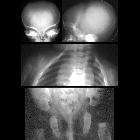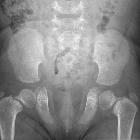Kleidokraniale Dysplasie

School ager
with hypermobile shoulders. AP radiograph of the clavicles (above) shows them to be hypoplastic in appearance. AP radiograph of the pelvis (below) shows delayed ossification of the pubic symphysis.The diagnosis was cleidocranial dysostosis.

Toddler with
drooping shoulders. AP and lateral radiographs of the skull (above) show multiple wormian bones in the lambdoid sutures. CXR AP (middle) shows complete absence of the clavicles bilaterally. AP radiograph of the pelvis (below) shows delayed ossification of the pubic bones giving the appearance of pseudo-diastasis of the symphysis pubis.The diagnosis was cleidocranial dysostosis.

Radiological
review of skull lesions. Cleidocranial dysostosis. Axial (a) and coronal (b, c) head CT images show islands of intra-sutural bones (dashed arrows) in the lambdoid and sagittal sutures representing wormian bones. Chest radiograph (d) in the same patient depicts hypoplasia of the bilateral clavicles (arrows), confirming cleidocranial dysostosis

Cleidocranial
dysostosis • Cleidocranial dysostosis - Ganzer Fall bei Radiopaedia

Cleidocranial
dysostosis • Cleidocranial dysostosis - Ganzer Fall bei Radiopaedia

Cleidocranial
dysostosis • Absent clavicles - Ganzer Fall bei Radiopaedia

Cleidocranial
dysostosis • Cleidocranial dysostosis - Ganzer Fall bei Radiopaedia

Cleidocranial
dysostosis • Cleidocranial dysostosis - Ganzer Fall bei Radiopaedia

Cleidocranial
dysostosis • Cleidocranial dysostosis - Ganzer Fall bei Radiopaedia

Cleidocranial
dysostosis • Cleidocranial dysostosis - Ganzer Fall bei Radiopaedia

Cleidocranial
dysostosis • Cleidocranial dysostosis - Ganzer Fall bei Radiopaedia

Cleidocranial
dysostosis • Cleidocranial dysostosis - Ganzer Fall bei Radiopaedia

Wormian bone
• Cleidocranial dysostosis - Ganzer Fall bei Radiopaedia
Cleidocranial dysostosis (CCD), also known as cleidocranial dysplasia, is a rare skeletal dysplasia with predominantly membranous bone involvement, which carries an autosomal dominant inheritance .
Clinical presentation
- large head, with large fontanelles with delayed closure
- broad mandible
- supernumerary teeth
- high arched palate
- neonatal distress due to thorax being narrowed and bell shaped
- excessively mobile and drooping shoulders
- may have genu valgum and short fingers
Pathology
It is a rare polyostotic skeletal dysplasia caused by a mutation in CBFA1 gene in AD inherited or sporadic mutation pattern (in approximately 40%) which is characterized by incomplete intramembranous ossification of midline skeletal structures inclusive of the clavicle as well as a defective development of the pubic bones, vertebral column, and long bones .
Radiographic features
Plain radiograph
Skull
- multiple wormian bones
- widened sagittal sutures and/or fontanelles
- premature fusion of the coronal suture (brachycephaly)
- frontal and/or parietal bossing
- basilar invagination (atlantoaxial impaction)
- persistent metopic suture
- supernumerary or abnormal teeth
- abnormal ear structures with hearing loss
Chest
- hypoplasia/aplasia of the lateral clavicle (absent clavicles): may have two separate hypoplastic segments
- supernumerary ribs
- hemivertebrae with spondylosis
- small and high scapulae
Pelvis
- hypoplasia of iliac bones
- absent/delayed ossification of the pubic bone creating the appearance of a pseudo-widening of the symphysis pubis
Limbs
- short/absent fibula
- short/absent radius
- coxa vara
- hypoplastic terminal phalanges
- pseudoepiphysis of metacarpals and metatarsal bones
Siehe auch:
- Basiläre Impression
- Coxa vara
- Wormsche Knochen
- Skelettdysplasie
- Pyknodysostose
- Halbwirbel
- Hypophosphatasie
- überzählige Zähne
- Brachyzephalie
- Mandibuloakrale Dysplasie
- CAP-Syndrom
- Crane-Heise-Syndrom
- Yunis-Varon-Syndrom
- Foramina parietalia mit kleidokranialer Dysostose
- absent clavicles
und weiter:
- angeborene Wirbelanomalien
- frontal bossing
- Kongenitale Klavikulapseudarthrose
- clavicle abnormalities (paediatric)
- mesiodens
- Platybasie
- basilar invagination (mnemonic)
- Zahnretention
- ACJ erosion
- wormian bones (mnemonic)
- Geburtstraumatische Claviculafraktur
- distal clavicular erosion
- paediatric clavicle abnormalities
- Erweiterung der Symphysis pubica
- hypoplasia of the clavicles
- zapfenförmige Epiphyse

 Assoziationen und Differentialdiagnosen zu Kleidokraniale Dysplasie:
Assoziationen und Differentialdiagnosen zu Kleidokraniale Dysplasie:








